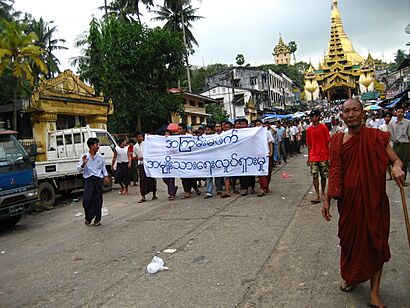Saffron Revolution facts for kids
Quick facts for kids Saffron Revolution |
|||
|---|---|---|---|
| Part of the colour revolutions | |||

Young people in Yangon holding a banner that says non-violence: national movement in Burmese. The famous Shwedagon Pagoda is in the background.
|
|||
| Date | 15 August 2007 – 26 September 2008 | ||
| Location | |||
| Caused by |
|
||
| Goals |
|
||
| Methods | Peaceful protests, marches, non-violent actions | ||
| Resulted in | Protests were stopped, but led to some political changes and a new government later on. | ||
| Parties to the civil conflict | |||
|
|
|||
The Saffron Revolution (Burmese: ရွှေဝါရောင်တော်လှန်ရေး) was a series of big protests in Myanmar (also known as Burma). These protests happened in August, September, and October 2007. They were about money problems and the way the country was run.
The protests started because the military government removed help for fuel prices. This made the cost of diesel and petrol go up by 66% to 100%. The price of natural gas for buses went up by 500% in less than a week!
Students, political activists, women, and Buddhist monks led these protests. They used peaceful methods, meaning they did not use violence. This is also called civil resistance.
The government arrested many protesters. In September 2007, thousands of Buddhist monks started leading the protests. They wore saffron-colored robes, which is why it's called the "Saffron Revolution." The government stopped these protests with force in late September 2007.
We don't know the exact number of people who died. Estimates range from 13 to 31 deaths. Many hundreds of people were arrested. Some were later released. The leader of the military government, Senior General Than Shwe, stayed in power until 2011.
Contents
What Was the Saffron Revolution?
The Saffron Revolution was a time when many people in Myanmar stood up against their government. It was a series of protests that lasted for a few months in 2007. People were unhappy with how the country was being run. They wanted more freedom and a better life.
Why Did People Protest?
There were several reasons why people decided to protest. The main reason that started everything was a sudden increase in fuel prices. The government stopped helping to pay for fuel, so prices shot up very quickly. This made it hard for people to afford transport and other basic needs.
People were also unhappy with the military government that ruled Myanmar. They felt that the government was unfair and did not respect their rights. Many people wanted to have a say in how their country was governed. They wished for democracy, where people can choose their leaders.
How Did the Protests Happen?
The protests began with students and activists. They marched and held demonstrations. Soon, many ordinary people joined them. The protests became much bigger when thousands of Buddhist monks started to lead them. Monks are highly respected in Myanmar.
The monks marched peacefully through the streets. They wore their traditional saffron-colored robes. This is why the protests became known as the Saffron Revolution. They walked to important places like the Shwedagon Pagoda. They called for change and for the government to listen to the people.
What Happened Next?
At first, the government allowed the monks to protest. But then, they started to crack down. This means they used force to stop the protests. Many protesters were arrested or put in jail. Some people were hurt or even died during this time.
Even though the protests were stopped, they brought a lot of attention to Myanmar. People around the world saw what was happening. The Saffron Revolution showed the world that many people in Myanmar wanted change. While the military leader stayed in power for a few more years, the protests helped lead to some political changes later on. In 2010, there was an election, and in 2011, some reforms began.
Images for kids
-
Protesting monks gathering at the Shwedagon Pagoda in Yangon
-
A "Free Burma" banner in Portland, Oregon.
-
Protesters against the military government in Myanmar, in Kuala Lumpur, Malaysia on 5 October.
-
Protesters march in Kitchener, Ontario
See also
- All Burma Monks' Alliance
- Buddhism in Myanmar
- Burma VJ – A documentary film made from footage taken during the revolution.
- Energy crisis
- Myanmar protests (2021–present)










